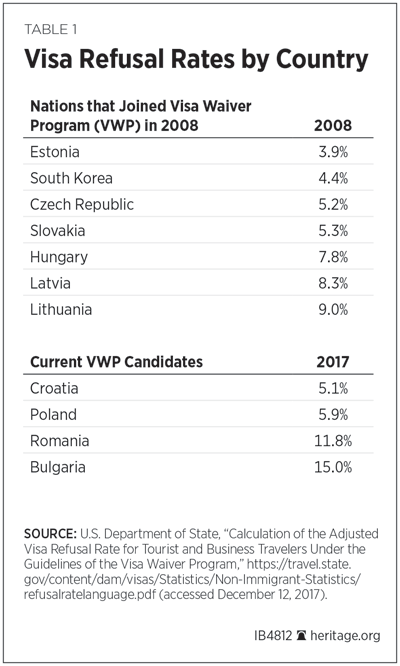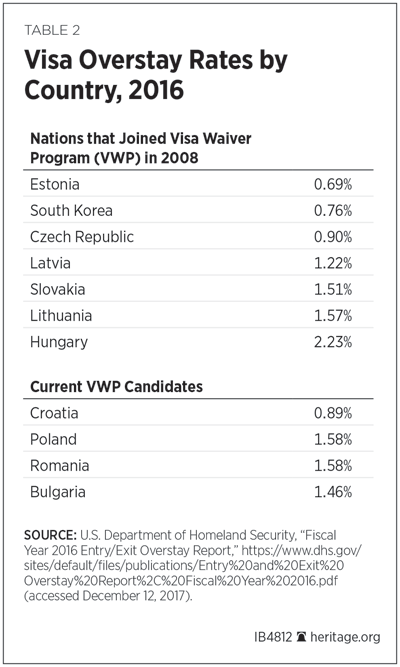The Visa Waiver Program (VWP) has a proven track record of improving U.S. security, expanding travel and tourism to the U.S., and deepening diplomatic ties between the U.S. and VWP members. However, the expansion of the program has slowed down to a stop, leaving important and worthy partners outside the program. In 2010, for example, President Barack Obama promised VWP membership to Poland but failed to fulfill that promise. Congress and the Trump Administration should work together to judiciously expand this valuable program to the appropriate partners and allies.
VWP Is the Gold Standard for Security
The VWP allows citizens of a member country to travel to the U.S. for up to 90 days without a visa. In order to become a VWP member country, a country must:
- Demonstrate a non-immigrant-visa-refusal rate (the percentage of visa applicants denied by the State Department for a particular nation) of no more than 3 percent;
- Issue its citizens secure, machine-readable biometric e-passports; and
- Present no discernable threat to U.S. law enforcement or U.S. national security.
Currently, 38 nations participate in the VWP.[REF] As required by the VWP and associated laws, these nations have also agreed to certain obligations. Thus, they:
- Share intelligence about known or suspected terrorists with the U.S. (per Homeland Security Presidential Directive 6 (HSPD-6));
- Exchange biographic, biometric, and criminal data with the U.S. (automated, via Preventing and Combating Serious Crime (PCSC) agreements);
- Share information on lost and stolen passports (LASP agreements);
- Increase their own airport security requirements; and
- Provide U.S. citizens with a reciprocal ability to travel to that country without a visa.[REF]
These features greatly enhance security by providing U.S. law enforcement and security agencies with more information and intelligence on potential terrorists and other bad actors. The VWP makes it easier for U.S. officials to know whether an individual presents a security threat. Indeed the Government Accountability Office found that the VWP “has enhanced U.S. traveler-screening capabilities and improved U.S. agencies’ ability to prevent known and suspected terrorists from traveling to the United States” and “has aided criminal investigations.”[REF] The VWP also allows the State Department to focus its consular and visa resources on those countries and individuals about which less is known and that are greater risks to U.S.security.
Visa Refusal and Visa Overstay
Joining the Visa Waiver Program currently requires a visa-refusal rate of less than 3 percent, but the Secretary of Homeland Security formerly had the authority to modify this requirement to accept countries with refusal rates of up to 10 percent. Indeed, the last major expansion of the program occurred in November 2008 when seven countries were admitted to the program, all with visa-refusal rates higher than 3 percent. Today, several countries have refusal rates on par with these seven countries’ refusal rates when they were admitted in 2008, as evidenced by Table 1.[REF]

Of course, a far better metric of determining the immigration risk from a country is the visa-overstay rates. While refusal rates are based on the subjective and differing judgment of individual consular officers, overstay rates are objective facts regarding how many visitors from a given country did not leave the U.S. when they should have. Looking at overstay rates in Table 2, multiple candidate nations are once again comparable to nations that have been previously admitted.[REF]

Shifting focus from visa-refusal rates to visa-overstay rates will allow low-risk countries to join the program.
Candidate Countries Already Meeting Other Requirements
Other than not having a visa-refusal rate of less than 3 percent, many countries that want to join the program are already meeting, or close to meeting, the requirements for joining and participating in the program. For example, Croatia entered into memoranda of understanding regarding LASP (2008), HSPD-6 (2008), and PCSC (2011), meeting the requirements to share information with U.S.[REF] Croatia also provided Americans with visa-free travel to Croatia in 1997 and has been issuing biometric e-passports since 2009.[REF] Similarly, Poland provides information on LASP through Interpol, signed and implemented HSPD-6 information sharing in 2011, and has initialed a PCSC information-sharing agreement but has yet to ratify it.[REF]
Since these countries are already meeting all, or almost all, of the other requirements for the program, the only thing standing in the way of VWP expansion is the refusal rate. This makes expansion relatively simple—reinstating the visa-refusal-rate waiver up to 10 percent and adding a requirement for low visa-overstay rates will allow at least Poland and Croatia to join the program.
Many Benefits for the U.S.
Beyond these security enhancements and improved information sharing, VWP expansion would also grow the U.S. economy. Again, looking at the last major expansion of the program in 2008, more citizens of VWP-member countries visited the U.S., and spent more money here than previously. A case in point is South Korea. After joining the program in 2008, the number of South Korean visitors to the U.S. increased by 132 percent by 2015. This increase in visits resulted in a 58 percent increase in spending on travel and tourism by South Koreans in the U.S. during this time frame.[REF] Visitors from Taiwan, which is the only country to join the program since the visa-refusal rate was reduced to 3 percent, increased 33 percent from 2012 to 2013 after joining the program.[REF] Making it easier to travel to the U.S. also makes it easier to do business in and with the United States. The VWP is a clear economic win for the U.S.
The VWP also allows the U.S. to affirm its alliances and partnerships. With an increasingly aggressive Russia, the U.S. can show its commitment to Eastern Europe by allowing countries like Poland to join the VWP. Expanding travel between the U.S. and VWP member countries also deepens cultural and public diplomacy.
Expanding and Improving a Valuable Program
Congress and the Trump Administration should work together to:
- Add an alternative eligibility requirement for low visa-overstay rates. Congress should allow the Secretary of Homeland Security to raise the 3 percent refusal rate to 10 percent if a country has a low visa-overstay rate.
- Rename the Visa Waiver Program. In Washington, semantics matter. “Visa waiver” is often incorrectly associated with lax vetting of foreign travelers. To avoid this confusion, Congress or the Department of Homeland Security should rename the VWP. One recommendation is to rename the program Partnership for Secure Travel (PST). This title recognizes the reciprocal, mutually beneficial nature of the program—as well as the security boon the program is to the U.S.
- Create a tier of rewards to motivate more countries to share information with the U.S.Countries that do not meet all the eligibility criterion should be able to join the program under a “preferred” or “associate” status. As a preferred or associate nation, these countries would receive fewer benefits than full-fledged partner countries.[REF]
Expanding VWP IS Good for America
Expanding the VWP will make the U.S. safer and more prosperous while also deepening its ties with allies and friends abroad. As such, Congress and the Administration should work to judiciously expand and rename the Visa Waiver Program.
—David Inserra is a Policy Analyst for Homeland Security and Cyber Security in the Douglas and Sarah Allison Center for Foreign Policy, of the Kathryn and Shelby Cullom Davis Institute for National Security and Foreign Policy, at The Heritage Foundation.


